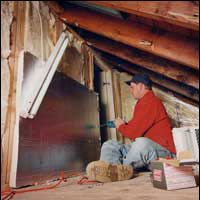In an effort to promote energy conservation, the Environmental Protection Agency started the Energy Star program in 1992. What began as a way to cut down on the energy drain from computers now covers more than 50 product categories. The program has evolved, of course, but the purpose remains the same: to conserve energy through innovations in technology.
Energy Star was designed as a voluntary program to promote energy-saving innovations by providing consumers with objective information about products -- not everyone has the time or resources to investigate how much energy one ceiling fan or dishwasher saves over another. The Energy Star label indicates that the product uses less energy than other products in that category -- you're probably familiar with it on appliances or heating and cooling equipment, but you can also find the label on roofing materials, commercial products and indoor air quality products. The EPA has also extended the Energy Star label to cover new homes, commercial buildings and industrial structures.
Advertisement
According to the Department of Energy, "Last year alone, Americans, with the help of Energy Star, saved enough energy to power 10 million homes and avoid greenhouse gas emissions from 12 million cars -- all while saving $6 billion."
The price of converting to Energy Star products can be high at the outset. To make a refrigerator more energy-efficient, for instance, manufacturers must spend money to research and develop energy innovations. While Energy Star encourages manufacturers to find cheaper ways to produce these products, the cost of innovation is often passed along to the buyer. But you can recoup the cost over time with lower utility bills, and the federal government and some local governments also offer rebates and tax breaks to encourage consumers to convert to Energy Star.
But what exactly is Energy Star, and what does it mean for the products we use? In this article, we'll look at how Energy Star got its start and where it's headed. We'll find out how much energy a product must conserve to get the Energy Star label, as well as what homeowners can do to build or remodel their homes so they can have an Energy Star home. Finally, we'll find out just how much money you can save with rebates and tax breaks by using Energy Star products.
Advertisement




